Imagine flying through the night at high speed, dodging branches, finding insects mid-air, and navigating pitch-black caves—all without using your eyes.
For bats, this isn’t imagination. It’s everyday life.
These nocturnal mammals have mastered a skill that’s more advanced than any human sonar system: echolocation—a natural form of biological sonar that lets them “see” with sound.
But how exactly does echolocation work? And how can it be so precise that a bat can catch a mosquito in total darkness?
Let’s dive into the science of how bats navigate the night without using their eyes.

1. What Is Echolocation?
Echolocation is the process of:
- Emitting sound waves
- Waiting for them to bounce off objects
- Interpreting the returning echoes to create a mental “image” of the environment
It’s like shouting in a cave and knowing the size and shape of the room just from how the echo sounds.
Except bats do this dozens of times per second—and with incredible accuracy.
2. The Mechanics: How Bats Use Sound to “See”
Bats emit high-frequency calls—often ultrasonic (above the range of human hearing)—through their:
- Mouth
- Or nostrils (depending on the species)
These sound waves hit objects (like trees, walls, or insects), bounce back, and are picked up by the bat’s highly sensitive ears.
From these echoes, the bat can tell:
- Distance (how long it takes the sound to return)
- Size and shape of the object
- Whether it’s moving and in which direction
- Even texture (is it a leaf, or a moth wing?)
Some bats can even detect the fluttering of insect wings.
3. Better Than Vision in Some Cases
While many bats do have functioning eyes, echolocation gives them superpowers that vision can’t match, such as:
- Navigating in total darkness
- Detecting camouflaged prey
- Flying through dense forests or caves without crashing
In fact, bats that live in open spaces rely more on eyesight, while those in dense areas or caves rely more heavily on echolocation.
4. Evolution’s Acoustic Masterpiece
Echolocation didn’t happen overnight—it evolved over millions of years.
What’s amazing:
- Different bat species developed different sonar “frequencies” to specialize in certain environments
- Some use broadband calls for complex spaces (like forests)
- Others use narrowband calls for long-range detection (like in open air)
Even more incredible: toothed whales and dolphins evolved a similar echolocation system—independently, through convergent evolution.
5. Echolocation in Action: Catching a Mosquito Mid-Air
Bats can emit up to 200 clicks per second during hunting.
This rapid-fire sound mapping helps them:
- Track fast-moving prey
- Adjust flight in real-time
- Avoid obstacles, like tree branches or other bats
They’re basically flying computers—processing sound, reacting, and correcting their path in milliseconds.
6. Not All Bats Use Echolocation (Surprise!)
While most bats do use echolocation, a few don’t—like some species of fruit bats (also called flying foxes).
These bats rely on:
- Excellent vision
- Sharp sense of smell
They tend to live in open environments and feed on fruit and nectar, not insects.
So yes—bats can have good eyes, too. Just not all of them need sonar.
7. Humans Inspired by Bats
Echolocation isn’t just for bats anymore.
Scientists and engineers have studied bats to improve:
- Sonar and radar systems
- Self-driving car sensors
- Drones that navigate indoors
- Mobility aids for visually impaired people, including sonar-like devices
Some blind individuals have even learned human echolocation—using tongue clicks to “see” the world around them!
Final Thoughts: A World Built on Echoes
Bats show us that there’s more than one way to sense the world. While we rely on sight, they rely on soundscapes—bouncing off surfaces and coming back as a mental map.
It’s a reminder that perception isn’t limited to eyes—and that evolution finds incredible solutions when the environment demands it.
So the next time you hear a chirp in the night, remember: it might not be a cry—it might be a map in the making.
“How Bats See Without Eyes: The Science of Echolocation”




The language of the input text is English.
Echolocation is truly fascinating, especially how bats use it to navigate and hunt in complete darkness. It’s incredible that this ability evolved over millions of years to become so precise. Scientists have even adapted this concept to improve technology, showing how nature inspires innovation. Understanding echolocation could lead to even more advancements in fields like robotics and navigation. How might echolocation continue to influence future technological developments?
Hi there Adventure Travel! 😊 Thank you so much for your thoughtful comment — you brought up a fascinating point!
Echolocation truly is one of nature’s most remarkable abilities, and the fact that it’s already inspiring technologies like self-driving car sensors, intelligent navigation systems for robots, and even assistive tools for the visually impaired shows just how powerful biomimicry can be.
In the future, echolocation could continue to influence technology in exciting ways, such as:
Autonomous rescue drones that can navigate through low-visibility environments like forests, caves, or disaster zones;
Non-invasive medical imaging tools, providing even more precision than current ultrasound techniques;
GPS-free underwater navigation systems, inspired by bats and dolphins;
Advancements in AI and real-time sensory processing, mimicking how animals like bats interpret sound data with incredible accuracy.
Nature is an endless source of intelligent design, and the more we study behaviors like echolocation, the more technological innovation we unlock.
What about you—what area do you think echolocation-inspired tech could transform next?